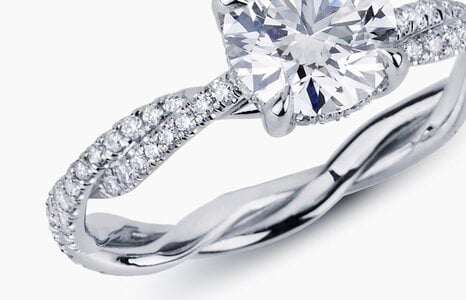Hi,
I am new in this forum and I am looking for an engagement ring. After a lot of research I already know many things that I want in the ring:
- 14k yellow gold
- 6 prongs
- ~1ct lab diamon (i think in europe bigger is too much)
- low profile (easier for everyday life)
- ~2mm thickness
- Pave (at most 50-70% of the shank to allow some resizing)
The most challenging part for me to decide now is the pave part. Usually the styles that I like the most involve some level of micropave:
- - https://www.jamesallen.com/engageme...old-trio-micropave-engagement-ring-item-53113
-
Unfortunately my understanding is that the more and the smaller the pave, the higher chance of diamonds falling. Also multirow pave seems not to work well with having more rings in the same finger.
Overall, I definitely would like to avoid having to go several times to get diamonds back in place. So I am looking for a tradeoff between beautiful and practical.
So finally I want to get your opinion on the durability of a twisted pave like the following:
- https://www.jamesallen.com/engageme...-gold-twisted-pave-engagement-ring-item-53390
- https://www.brilliantearth.com/Nova-Halo-Diamond-Ring-(1/2-ct.-tw.)-Gold-BE1D25241-1517747/
In particular, how it compares in the one hand with micropaves or multi row pave, and on the other hand with simple one row paves.
Thank you in advance!
I am new in this forum and I am looking for an engagement ring. After a lot of research I already know many things that I want in the ring:
- 14k yellow gold
- 6 prongs
- ~1ct lab diamon (i think in europe bigger is too much)
- low profile (easier for everyday life)
- ~2mm thickness
- Pave (at most 50-70% of the shank to allow some resizing)
The most challenging part for me to decide now is the pave part. Usually the styles that I like the most involve some level of micropave:
- - https://www.jamesallen.com/engageme...old-trio-micropave-engagement-ring-item-53113
-
Unfortunately my understanding is that the more and the smaller the pave, the higher chance of diamonds falling. Also multirow pave seems not to work well with having more rings in the same finger.
Overall, I definitely would like to avoid having to go several times to get diamonds back in place. So I am looking for a tradeoff between beautiful and practical.
So finally I want to get your opinion on the durability of a twisted pave like the following:
- https://www.jamesallen.com/engageme...-gold-twisted-pave-engagement-ring-item-53390
- https://www.brilliantearth.com/Nova-Halo-Diamond-Ring-(1/2-ct.-tw.)-Gold-BE1D25241-1517747/
In particular, how it compares in the one hand with micropaves or multi row pave, and on the other hand with simple one row paves.
Thank you in advance!








300x240.png)